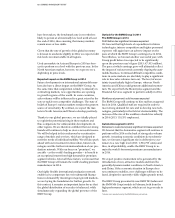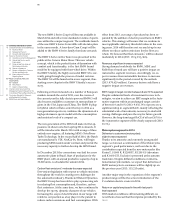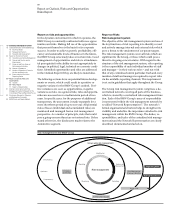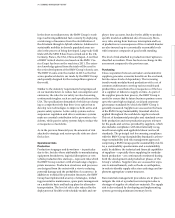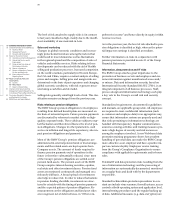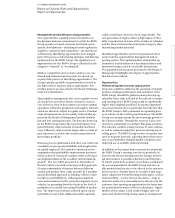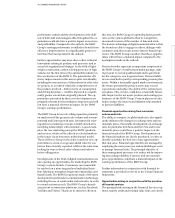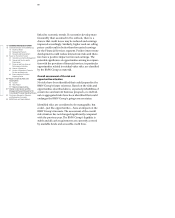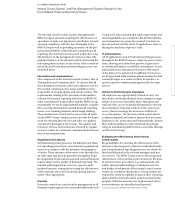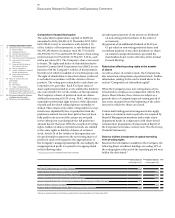BMW 2013 Annual Report Download - page 75
Download and view the complete annual report
Please find page 75 of the 2013 BMW annual report below. You can navigate through the pages in the report by either clicking on the pages listed below, or by using the keyword search tool below to find specific information within the annual report.
75 COMBINED MANAGEMENT REPORT
Credit and counterparty default risk
Credit and counterparty default risk arises within the
Financial Services segment if a contractual partner (i. e.
a customer or dealer) either becomes unable or only
partially able to fulfil its contractual obligations, such
that lower income is generated or losses incurred. The
Financial Services segment utilises a variety of rating
systems in order to assess the creditworthiness of its
contractual partners. Credit risks are managed at the
time of the initial credit decision, based on a calculation
of the present value of standard risk costs and subse-
quently, during the term of the credit, by using a range
of risk provisioning techniques to cover risks emanat-
ing from changes in customer creditworthiness. In this
context, individual customers are classified by category
each month on the basis of their current contractual
status, and appropriate levels of allowance recognised
in accordance with that classification.
The level of risk attached to credit and counterparty de-
fault risks in the short and medium term is high. The
potential impact on earnings is classified as medium.
Residual value risk
A related residual value risk exists if the expected mar-
ket value of a vehicle at the end of the contractual term
is lower than its residual value calculated at the date the
contract is entered into. Each vehicle’s market value is
forecast on the basis of historical external and internal
data and used to predict the expected market value of
the vehicle at the end of the contractual period. As part
of the process of managing residual value risks, a calcu-
lation is performed at the inception of each contract to
determine the present value of risk costs. Market
devel-
opments are observed throughout the contractual period
and the risk assessment updated appropriately.
High levels of risk are attached to residual value risks
in the short and medium term. The potential impact on
earnings for the segments affected in the short and
medium term is classified as medium. The potential im-
pact on earnings for the Group is classified as medium.
Interest rate risks
Interest rate risks in the Financial Services segment
relate to potential losses caused by changes in market
interest rates and can arise when fixed interest rate
pe-
riods for assets and liabilities recognised in the balance
sheet do not match. Interest rate risks in the Financial
Services line of business are managed by raising refinanc-
ing
funds with matching maturities and by employing
interest rate derivatives. Interest rate risks are also
managed on the basis of a value-at-risk approach and
stipulated limits. Limits are set using a benchmark-
oriented approach that focuses on interest rate arrange-
ments
contained in the original contracts.
The level of risk attached to interest rate risks in the
short and medium term is medium. The potential im-
pact on earnings in the short and medium term is
classified as low.
Liquidity and operational risks
Use of the “matched funding principle” to finance the
Financial Services segment’s operations eliminates
liquidity risks to a large extent. Regular measurement
and monitoring ensure that cash inflows and out-
flows
from transactions in varying maturity cycles and
currencies offset each other. The relevant procedures
are incorporated in the BMW Group’s target liquidity
concept.
Operational risks are defined in the Financial Services
segment as the risk of losses arising as a consequence
of
the inappropriateness or failure of internal procedures
(process risks), people (personnel-related risks), sys-
tems
(infrastructure and IT risks) and external events
(external risks). These four categories of risk also include
related legal and reputation risks.
As part of the process of managing operational risks,
loss events and risk scenarios are recorded in the
Operational Risk Management Suite (OpRisk-Suite) by
OpRisk Officers from the various individual units or
entities, along with details of probability of occurrence,
loss amounts and countermeasures. This comprehen-
sive recording and measurement of risk scenarios and
loss events in the OpRisk-Suite provides the basis for
a systematic analysis of potential and / or actual opera-
tional risks. Annual self-assessments are also carried
out. In conjunction with the assessment of risk-bearing
capacity, operational risks are measured using the
standard approach and compared with the correspond-
ing limit.
The level of risk attached to operational risks is medium.
The potential impact on earnings is classified as low.
Legal risks
Compliance with the law is a basic prerequisite for
the success of the BMW Group. Current law provides
the binding framework for the BMW Group’s various


